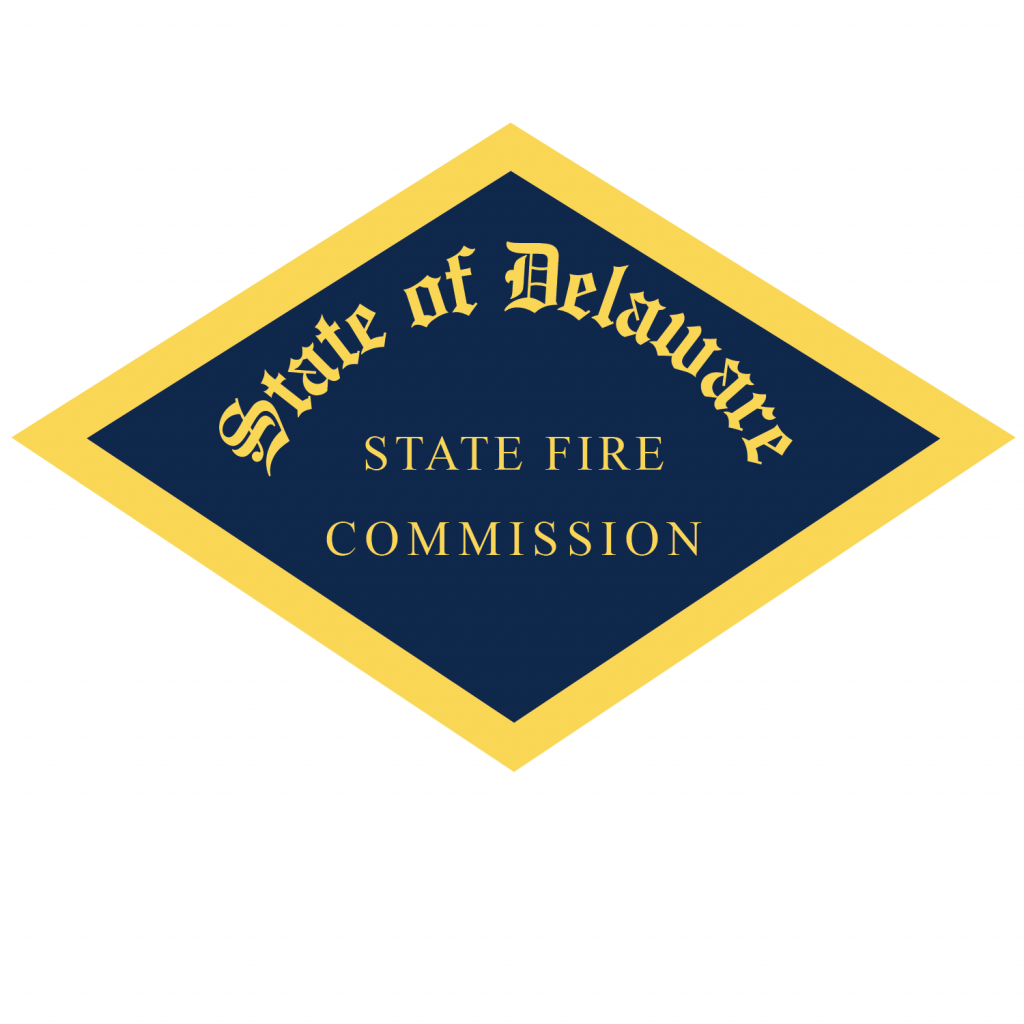History of the Delaware State Fire Commission
The State of Delaware, Office of State Fire Marshal, was established July 10, 1953. Volunteer Firemen throughout the state, the County Fire Associations, the Delaware Volunteer Firemen’s Association and Governor J. Caleb Boggs worked diligently for passage of the legislation to create the agency.
The original law establishing the office required the governor to appoint the State Fire Marshal for a term of four years. The duties and powers are the same as listed in the present law: Title 16, Chapter 66, §6607.
The Office of the State Fire Marshal was responsible for Fire Safety, Fire Prevention, Fire Protection, and participation in the Civil Defense Program established at that time.
Arson constituted a serious problem at this time. Arson Investigators from the National Board of Fire Underwriters provided assistance to the State Fire Marshal.
In 1955, the National Board of Fire Underwriters Fire Code was recommended to the General Assembly for adoption. It was never brought out of committee. This inaction led to the passage of
H.B. 560 in 1953. (Title 16, Chapter 4, 405 – 407) which created the five-member State Fire Prevention Commission to assist the State Fire Marshal in preparing items of this type for future legislation and to approve the operating budget for the Office.
During fiscal year 1958, the State experienced four large-loss-industrial fires which influenced passage of Title 16, Chapter 66, & 6601 – 6608 in 1959. The legislation revised the State Fire Prevention Commission from 5 members to 6 members. It authorized the Commission to promulgate, amend, and repeal regulations for the safeguarding of life and property from the hazards of fire and explosion, thus removing this function from legislative action by the General Assembly which heretofore had been unsuccessful.
Other functions of the Commission authorized by the revised legislation included appointment of the State Fire Marshal for terms of four years, authority to hold public hearings, power to issue subpoenas and hear appeals. Prior to the revised legislation, the Governor appointed the State Fire Marshal, appeals were heard in Superior Court and any fire prevention codes required legislative action.
The need for training for the state’s volunteer fire service surfaced as a major concern in the early 1960’s. Availability of training was limited to one annual fire school sponsored by the Delaware Volunteer Firemen’s Association and a limited number of evening classes provided by the State Department of Vocational Education. These combined efforts reached only a small number of the firefighters who needed training. The need to establish a State Fire School became the major legislative issue for the volunteer fire service.
In 1964 the Fire School bill was passed. Once again, the jurisdiction for this fire service institution was placed under the jurisdiction of the State Fire Prevention Commission, Title 16, Chapter 66,
6613 – 6618.
Commission authority includes appointment of the Director and other employees as may be recommended by the Director, the establishment of admission fees and other fees that it may deem necessary for the training given and the Fire School may “undertake any project and engage in any activity which in the opinion of the Fire Prevention Commission will serve to protect the public safety.”
During this same period of time, the volunteer fire service recognized the need to regulate the formation of new fire companies to assure that adequate fire protection was available to the citizens of Delaware and that a proliferation of volunteer fire companies at every crossroad did not occur.
Once again, with the support of the volunteer fire service, this regulatory authority was legislated to the State Fire Prevention Commission. (Title 16, Chapter 66, 6619). This authority was later expanded in 1982 to include substations; to resolve boundary and other disputes; prohibit cessation of necessary fire protection services.
In the early seventies, the Federal focus on Highway Safety emphasized the need for training and certification of emergency medical service personnel within the States. State regulation of ambulance personnel was a requirement imposed by the Federal Government for the State to be eligible to receive highway safety funds. Initial legislation drafted named the Department of Health as the regulatory agency. The volunteer fire companies strongly opposed the provision and recommended that the State Fire Prevention Commission be named as the regulatory agency. If regulations were required to keep the State eligible for federal funding, then those regulatory functions should rest with the Commission. The volunteer fire service felt that the members of the Commission were more in tune with the problems and concerns involved in the delivery of emergency medical services than any other agency within state government. Once again, the volunteer fire service was successful in having the Commission assume that responsibility on its behalf. On July 1, 1972, the Ambulance Service Regulations, promulgated by the State Fire Prevention Commission, became effective and Delaware became one of the first states, if not the first, to have statewide ambulance service regulations.
In 1970, the State of Delaware changed from the Commission form of government to a cabinet form. The only agency to be retained as a Commission with full powers, responsibilities and authority granted to it by legislation over a period of fifteen years was the State Fire Prevention Commission. The strong working relationship that existed between the volunteer fire service and the Commission was the primary reason that the Commission was not included in the reorganization.
Today, years after the reorganization and over fifty years after its creation, the State Fire Prevention Commission continues to provide a cabinet-level function as the Department of Fire Prevention within State Government with oversight over the Division of Delaware State Fire School and State
Fire Marshal and a strong working relationship with the volunteer fire service of Delaware.
The existence and functioning of the State Fire Prevention Commission over the past fifty-one years have addressed and alleviated the problems, conditions and/or situations as follows:
- It was created as an advisory group to assist the Fire Marshal in carrying out his duties and to approve a budget for operation of the office;
- Its powers were expanded to include the promulgation of regulations, the appointment of the State Fire Marshal and the authority to hear appeals;
- Regulations can be promulgated throughout the year without the need for legislative action. They can be amended and repealed in a like manner;
- Appointment of the Fire Marshal by the Commission provides more stability for the office since the appointment is not affected by changes in the Governorship. Five Fire Marshals have been appointed for the period 1959 – 2019;
- The authority for the Commission to hear appeals alleviates an overloaded Superior Court system of this responsibility;
- It was given jurisdiction over the Delaware State Fire School with the authority to appoint the Director:
- Appointment of the Director by the Commission provides more stability for the School since the appointment is not affected by change in the Governorship. The first Director was appointed in November 1964.
- Training program attendance has increased from a total of 450 in FY 1965 to 36,500 in FY 1992;
- Its authority to approve new fire companies and substations provides adequate fire protection services throughout the state with 63 volunteer fire companies operating a total of 63 stations and 22 substations;
- Its authority to regulate the predominately volunteer ambulance service has successfully maintained a reasonable number of certified EMT’s available for service. This continues to be a problem area, and it will worsen, as a result of the exposure to AIDS and other communicable diseases the volunteer EMT’s face on every response.
- Its authority to approve new fire companies and substations, resolve boundaries and other disputes, to prohibit cessation of services has been exercised on numerous occasions. Boundary disputes have been resolved. Cessation of services have been prevented. Several substations have been approved. Boundaries for all fire companies have been designated;
- Liaison with the volunteer fire companies continues in a strong and positive fashion. The Commission’s ability to understand the problems and concerns the volunteer fire companies face every day and its ability to be responsible to those problems and concerns is a major contributing factor towards maintaining an effective and efficient volunteer fire, rescue, and ambulance service.
- The 147th General Assembly amended Title 11 section 4101; this amended Title established the Volunteer Ambulance Company Fund. Furthermore, the “State Fire Prevention Commission” (SFPC) was tasked with providing these funds to Volunteer ambulance companies on a proportionate basis across the state and this number being based on approved dispatched ambulance runs. The SFPC distributes these funds on a bi-annual basis.
- The State Fire Prevention Commission absorbed the EMT Certification process formerly tasked by the Delaware State Fire School. The Commission staff officially began certifying Delaware EMTs in March 2017. The Fire Prevention Commission successfully transferred the responsibility without delay of certification and/or recertification of Delaware EMTs. There are approximately 1,710 EMTs certified in Delaware.
- The State Fire Prevention Commission absorbed the Ambulance Company Licensing and Ambulance Unit Permitting process formerly tasked by the Delaware State Fire School. The Commission staff officially began licensing ambulance companies, permitting ambulance units, and conducting inspections in 2014.
- The State Fire Prevention Commission absorbed the process of EMT Complaint Investigations formerly tasked by the Delaware State Fire School. The Commission staff officially began processing complaints in 2014.






